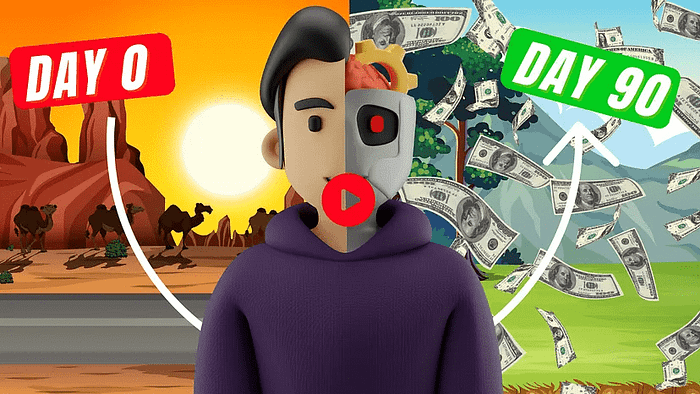I Tried Pinterest Affiliate Marketing For 30 Days Using AI
Have you ever wondered whether a Pinterest affiliate marketing strategy using AI is as profitable and straightforward as many claim on YouTube? I was curious too, so I decided to put it to the test over the last 30 days. Right before the end of my experiment, something interesting happened that shifted my perspective.
Let’s dive into what I did, what went wrong, and what you can learn from my experience. This blog will break down the steps I took, reveal my results, and share the insights I gained. The goal is to turn this into a full-time income opportunity, so let’s start by simplifying this business model.
We strongly recommend that you check out our guide on how to take advantage of AI in today’s passive income economy.
Table of Contents
Understanding Pinterest Affiliate Marketing
Pinterest operates as a visual search engine. Users search for keywords, view images (or pins), and click on these images to learn more. These pins can be linked to products or websites, allowing you to potentially earn money through affiliate links or advertisements.
This is the essence of Pinterest affiliate marketing: create engaging content to attract potential customers, guide them to your site, and earn commissions from their purchases. To succeed, you need eye-catching images, a platform to direct traffic to, and a way to monetize that traffic.
My Pinterest Affiliate Marketing Strategy
Setting Up Monetization
To monetize my Pinterest efforts, I chose the Amazon Associates program. This involved directing traffic to Amazon and earning a small commission from any purchases made through my affiliate links.
I utilized an old blog I had from years ago, which was also monetized with Amazon Associates but had been inactive. I revamped this old site to serve as my platform for this test.
For those without an existing website, there are alternatives. You could create a free site using Google Sites, or build a page on Kit.co, similar to an Amazon influencer page. Medium.com is another option, allowing you to publish articles and potentially earn from affiliate links and ad revenue. However, I preferred having full control over my landing pages, so I used my old blog for this test.
Creating Pins with AI
To create my Pinterest pins, I initially considered using Canva and Tailwind. However, I opted for a simpler approach by relying on AI tools. I started with Haen, which provides a URL-to-video feature for product reviews but later switched to ChatGPT for generating images and text.
Using ChatGPT, I created vertical images (9×6 ratio) for my pins, along with Pinterest titles and descriptions. This AI-driven approach was both efficient and cost-effective, given that ChatGPT’s latest version is available for free.
My Daily Routine
Every day, I used Pinterest’s Trends feature to identify popular search terms. I then asked ChatGPT to generate a brief article based on these keywords, which I posted on my blog.
Each article included Amazon affiliate links, and I enhanced their appearance with a WordPress plugin. Although a simpler link would suffice, I aimed for a polished presentation.
I also created a Pinterest pin for each article, using ChatGPT to design the image and craft the title and description. I repeated this process daily for 30 days.
Analyzing Results
Over the course of the 30 days, I saw a gradual increase in impressions as I added more pins. The graph indicating my Pinterest performance showed positive movement, suggesting some potential for success.
However, despite these signs of progress, I did not earn any money from my affiliate links during this period. This outcome was disappointing but provided valuable lessons.
Mistakes and Lessons Learned
Keyword Research
One major mistake was neglecting proper keyword research. Pinterest is a visual search engine, so targeting the right keywords is crucial. I relied on Pinterest’s trending page, competing with highly saturated and competitive keywords.
For a new Pinterest account, focusing on less competitive, long-tail keywords could be more effective. These are keyword phrases that are longer and less competitive, giving a new account a better chance to rank and attract traffic.
Frequency of Posting
Another mistake was posting only one pin per day. To increase your chances of success, you need to post more frequently. More pins mean more opportunities for impressions and clicks, accelerating your chances of success.
One pin daily is insufficient for a robust test of this strategy. I plan to increase my posting frequency to at least two or three times a day to better assess the effectiveness of my Pinterest affiliate marketing strategy.
Moving Forward
Given the insights from this trial, I plan to continue and refine my approach. My next steps involve using paid software for in-depth keyword research to identify the most effective keywords for my Pinterest pins.
Additionally, I will increase my posting frequency to improve my chances of gaining traction. This revised approach will offer a more comprehensive test of the Pinterest affiliate marketing strategy.
Conclusion
In conclusion, my 30-day experiment with Pinterest affiliate marketing and AI revealed both promising signs and significant areas for improvement. The increase in impressions indicates potential, but the lack of earnings underscores the need for better keyword strategies and more frequent posting.
I’ll be continuing this experiment with refined strategies and will share any successful outcomes or further insights with you. Stay tuned for updates on my journey and additional tips on mastering Pinterest affiliate marketing.
If you found this experience helpful and want to see more updates, make sure to follow along and stay engaged. I’ll keep you posted on any breakthroughs and additional findings from my ongoing efforts with Pinterest affiliate marketing using AI.
FAQs:
Is Pinterest Good for Affiliate Marketing?
Yes, Pinterest can be a valuable platform for affiliate marketing. It functions as a visual search engine where users search for ideas, products, and inspiration. By creating engaging pins that link to affiliate products or your blog, you can drive traffic and potentially earn commissions. Success on Pinterest depends on your ability to create high-quality, relevant pins, use effective keywords, and maintain a consistent posting schedule. With the right strategy, Pinterest can be an effective tool for generating affiliate income.
Can You Promote ClickBank Products on Pinterest?
Yes, you can promote ClickBank products on Pinterest. ClickBank offers a wide range of digital products and services, which can be linked through your Pinterest pins. To do this effectively, create visually appealing pins that include engaging descriptions and relevant keywords. Ensure that your pins comply with Pinterest’s advertising guidelines and include a clear call-to-action to direct users to your ClickBank affiliate link. Properly optimized pins can help drive traffic and conversions for ClickBank products.
Which Affiliate Marketing Strategy is the Most Effective?
The effectiveness of an affiliate marketing strategy can vary depending on your niche, audience, and goals. However, some commonly effective strategies include:
- Content Marketing: Creating valuable content that provides solutions or information relevant to your audience. This can include blog posts, videos, and infographics.
- Email Marketing: Building an email list and sending targeted offers and promotions to your subscribers.
- Social Media Marketing: Using platforms like Pinterest, Instagram, and Facebook to share engaging content and drive traffic to your affiliate links.
- SEO (Search Engine Optimization): Optimizing your content for search engines to increase organic traffic and improve the visibility of your affiliate offers.
- Paid Advertising: Running targeted ads on platforms such as Google Ads or Facebook Ads to reach a larger audience and drive conversions.
The most effective strategy depends on your specific situation, so it’s often beneficial to experiment with different approaches and analyze their performance to determine what works best for you.
How to Earn Commission on Pinterest?
To earn a commission on Pinterest, follow these steps:
- Set Up Your Affiliate Links: Sign up for an affiliate program that offers products or services relevant to your audience. Obtain your unique affiliate links.
- Create Engaging Pins: Design visually appealing pins that include high-quality images, compelling titles, and descriptions. Make sure your pins align with the interests and needs of your target audience.
- Link to Your Affiliate Offers: Embed your affiliate links in your pins. When users click on your pins, they should be directed to the product page or blog post where they can make a purchase.
- Optimize for Keywords: Use relevant keywords in your pin descriptions and titles to improve visibility in Pinterest searches.
- Monitor Performance: Track the performance of your pins using Pinterest Analytics. Evaluate which pins are driving the most clicks and conversions, and adjust your strategy accordingly.
By following these steps and consistently creating valuable content, you can effectively earn commissions through Pinterest affiliate marketing.

We strongly recommend that you check out our guide on how to take advantage of AI in today’s passive income economy.




